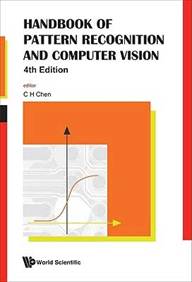|
Those regularly visiting ICPR know that the field of Pattern Recognition and Computer Vision is tremendously widespread – and rapidly moving. For those who want to keep track of what is going on, The Handbook of Pattern Recognition and Computer Vision provides a neat overview. As the book I read is the 4th edition, I expected some (revised) overview of the field, starting in the early days of PR&CV. Wrong. The handbook discusses recent advances, where recent means the last five years, more or less. Each edition differs completely (or at least very significantly) from previous editions (published in 1993, 1999, and 2005). Each edition also has it focus area – topics that were “hot” at that time. For instance, the 90’s were the time of booming syntactic recognition, the 2005 edition had human identification as central issue, and this issue emphasizes on life sciences and 3D problems. The series is dedicated to the late Prof. King-Sun Fu—well-known to the IAPR community. He was very active in PR&CV, exactly what these handbooks want to convey. Discussing all 33 chapters in depth would be impossible. Even the brief descriptions of each chapter in the book’s preface take three and a half pages: www.worldscibooks.com/etextbook/7297/7297_preface.pdf. Just as in the previous editions, the book consists of five parts. Standard are the chapters “Basic Methods in Pattern Recognition” and “Basic Methods in Computer Vision and Image Processing”, although the wording “image processing” is new, signaling a move towards imaging. Then “Recognition Applications” is the traditional chapter discussing the wide variety of (potential) PR applications, ranging from recognizing handwritings via emotions and remote sensing to solar image features. Contributions in Chapter 4 discuss the “hot topics”: “Computer Vision and Pattern Recognition in Life Sciences and Human ID”. Finally, the Chapter “System and Technology” covers several frameworks for e.g. face synthesis, video surveillance, and intelligent watermarking. To figure out the precise contents, just visit www.worldscibooks.com/etextbook/7297/7297_toc.pdf I personally find this book very useful as a handbook on my desk to get a first and quick impression of a certain topic “I always wanted to know but never dared to ask”. Furthermore, it is a clear candidate for any PR/CV library, just like its successors. Finally, it is very useful in a “selected recent topics in PR & CV” seminar, as most chapters in the chapters 3-5 are very suited for these topics. Chapters 1 and 2 can very well serve as core material for a PR & CV advanced course or seminar. Do I have any complaints? Well, actually hardly any. The only one that came up during reading was that the style template differs between chapters. I identified two styles that were very likely caused by using either LaTeX or Word as text processors. It would be nice if that could be harmonized in the next edition that theoretically should appear in 2015. Interesting guess is what the “hot topics” will be in 4 years. My bet is the inclusion of Computer Graphics—as 3D is getting more and more important—and parallel/GPU programming—since 3D computations simply require a tremendous amount of computing power. We’ll see! |
|
BOOKSBOOKSBOOKS
Handbook of Pattern Recognition and Computer Vision, 4th Edition
by C.H. Chen World Scientific, 2009
Reviewed by Arjan Kuijper (Germany) |
|
Click on the image above to go to the publisher’s web page for this book where you will find a description of the book and links to the Table of Conteents, the Preface to the 4th Edition, and Chapter 1.. |


